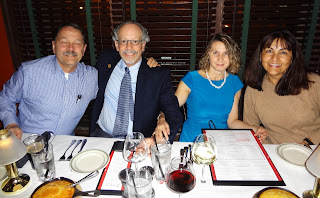The patient is an 11 y.o boy seen for an unrelated problem. His mother noted an alopecic area in her newborn and attributed it to something the obstetrician did,
O/E: There is a 1.5 xm area of alopecia on the left fronto-temporal area.
Diagnosis: Temporal (Congenital) Triangular Alopecia
We have presented two similar cases in the past.
Here is a free full text article from the Indian Journal of Dermatology
Monday, March 28, 2016
Sunday, March 27, 2016
Labial Macules
The patient is a 33 year-old woman who recently noted pigmented macules on her lower lips. She admits to having an anxiety disorder and being preoccupied with her health (which is otherwise excellent). Her anxiety dates back to the death of her father from colon cancer at age 52 (when she was 10 years old). She was seen for an unusual cheilitis in 2010 and her case was presented on VGRD then.
O/E: There are six lightly pigmented macules on her lower lip. No other pigmentation on her oral mucosae. No other pigmented macules noted.
Discussion: While these macules could be post-inflammatory changes from her allergic cheilitis, it's hard to ignore her family history and the possibility that they could be a forme fruste of Peutz-Jeghers Syndrome. Endoscopy seems, to me at least, to be indicated. With classical PJS the pigmented macules may be present even in infancy or childhood. Visualizing her G.I. tract is important here, if only to allay this woman's anxiety.
Your thoughts will be appreciated.
O/E: There are six lightly pigmented macules on her lower lip. No other pigmentation on her oral mucosae. No other pigmented macules noted.
Discussion: While these macules could be post-inflammatory changes from her allergic cheilitis, it's hard to ignore her family history and the possibility that they could be a forme fruste of Peutz-Jeghers Syndrome. Endoscopy seems, to me at least, to be indicated. With classical PJS the pigmented macules may be present even in infancy or childhood. Visualizing her G.I. tract is important here, if only to allay this woman's anxiety.
Your thoughts will be appreciated.
Saturday, March 19, 2016
Bullae and Erosions in a Newborn
Presented by Dr. Henry Foong
Ipoh, Malaysia
This 20-day-old baby presented with
multiple blisters on the hands and feet. The mother first noticed them on
Day 2 after a normal delivery when there were blisters on the hands.
Subsequently, she noticed blisters on the feet as well. These
blisters ruptured easily on friction or minimal rubbing. Recently he has
difficulty in swallowing as well. There was no fever. No family history
of similar problems and no history of consanguinity in the family.
He has seen paediatricians and dermatologists but his condition did not improve.
The child looks fretful. Superficial erosions with crusts were mainly noted on his hands and feet. A superficial bulla 0.5 x 0.5 cm was present on the left index finger. Mucosa of the lips appeared eroded. These was no nail involvement.
Do you see this condition? How do you manage this in your institution? I guess this will be a tough management problem for the child and the family.
Diagnosis: This child most likely has epidermolysis bullosa, probably recessive dystrophic EB, although the Hurlitz type needs to be considered as well.
Our pediatric dermatologists can help with management suggestions.
Definitive diagnosis can be obtained with biopsy. In the past, electron microscopy was utilized, but there may be simpler studies.
Note: At an appropriate time, if the diagnosis is more certain, the parents might want to visit the DEBRA site. There is a resources in Malaysian, in addition: DebraMalaysia.
Our pediatric dermatologists can help with management suggestions.
Definitive diagnosis can be obtained with biopsy. In the past, electron microscopy was utilized, but there may be simpler studies.
Note: At an appropriate time, if the diagnosis is more certain, the parents might want to visit the DEBRA site. There is a resources in Malaysian, in addition: DebraMalaysia.
References:
1. Recessive Dystrophic Epidermolysis Bullosa
A Review of Disease Pathogenesis and Update on Future
Therapies
Luis Soro, DO et. al J Clin
Aesthet Dermatol. 2015. 8(5): 41–46.
Abstract: Objective: Review the pathogenesis of recessive
dystrophic epidermolysis bullosa and provide an update on research currently
underway that is aimed at treating and potentially curing this severe skin
disorder. Design: Review article. Setting: Private practice and large teaching
hospital. Participants: None. Measurements: N/A. Results: Currently, patients
with recessive dystrophic epidermolysis bullosa are managed with only supportive
care. However, there are several promising new treatment avenues that may help
patients in the future. These include gene therapy, cell therapy, and
protein-based therapy. Each approach offers distinct advantages and
disadvantages. Conclusions: The advances in understanding the molecular basis
for epidermolysis bullosa over the last few decades has led to significant
progress in devising new treatment options. Though many of these approaches
remain several years away from regular implementation, it is an exciting time
for research in the field. Free Full Text.
2. Recessive Dystrophic Epidermolysis Bullosa: Advances in
the Laboratory Leading to New Therapies. Woodley DT, Chen M. J Invest Dermatol.
2015;135(7):1705-7. Free Full
Text.
Tuesday, March 08, 2016
In the Maze of the Technical Exhibit
zombies roam these halls
collecting priceless samples
in overstuffed bags
after exhausting themselves in the cavernous maze, a relaxing dinner sustained the weary tropers and their consorts.
Subscribe to:
Posts (Atom)









